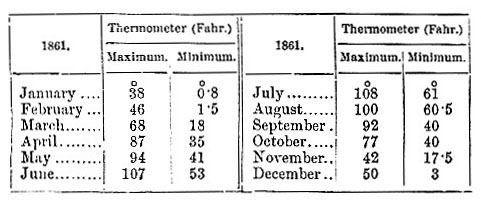1902 Encyclopedia > China > Provinces of China: Introduction. Chinese Provinces (1) - Chih-Li [Hebei].
China
(Part 7)
C. GENERAL DESCRIPTION OF CHINA PROPER
Provinces of China: Introduction. Province 1: Chih-Li [Hebei].
Provinces.—China Proper is divided into nineteen provinces,—Chih-li, Shan-tung, Shan-se, Ho-nan, Keang-soo, Gan-hwuy, Keang-se, Che-keang, Fuh-keen, Hoo-pih, Hoo-nan, Shen-se, Kan-suh, Sze-chuen, Kwang-tung, Kwang-se, Kwei-chow, Yun-nan, and Shing-king in Manchuria.
The metropolitan province of Chih-li, in which is situated Peking, the capital of the empire (see PEKING), contains eleven prefectural cities, and occupies an area of 58,949 square miles. By the latest census reports the population was returned as 27,000,000. This province forms part of the great delta plain spoken of above, with the exception of the mountain ranges which define its northern and western frontier. It is bounded on the E. by the Gulf of Pih-chih-li and Shan-tung, and on the S. by Shan-tung and Ho-nan. The proportion of Mahometans among the population is very large. In Peking there are said to be as many as 20,000 Mahometan families, and in Paou-ting Foo, the capital of the province, there are about 1000 followers of the Prophet. The extremes of heat and cold in Chih-li are very marked, as a glance at the accompanying table of the temperature at Tien-tsin during the year 1861, as chronicled by Dr Lamprey’s self-registering thermometer, will show.

During the months of December, January, and February the rivers are frozen up, and even the Gulf of Pih-chih-li is fringed with a broad border of ice. There are four rivers of some importance in the province, namely, the Peiho, which has been described above; the Wan-ho, which rises in the mountains in Mongolia, and flowing to the west of Peking, form a junction with the Peiho at Tien-tsin; the Shang-se-ho, which rises in the mountains on the north of the province of Shan-se, and takes a south-easterly course as far as the neighbourhood of Ki Chow, from which point it trends north-east, and eventually joins the Wan-ho some 15 miles above Tien-tsin; the Poo-to-ho, which rises in Shan-se, and after running a parallel course to the Shang-se-ho on the south, empties itself in the same way into the Wan-ho; and the Lan-ho, which rises in Mongolia, enters the province on the north-east after passing to the west 9o of Jehol, passes the city of Yung-ping Foo in its course (which is south-easterly) through Chih-li, and from thence winds its way to its mouth at the north-eastern boundary of the Gulf of Pih-chih-li. The province contains three lakes of considerable size. The largest is the Ta-loo-tsze Hoo, which lies in 37° 40´ lat. and 115° 20´ E. long; the second in importance is one which is situated to the E. of Paou-ting Foo; and the third is the Too-loo-tsze Hoo, which lies E. by N. of Shun-tih Foo. Four high roads radiate from Peking: one leading to Urga by way of Seuen-hwa Foo, which passes through the Great Wall at Chang-kea Kow; another, which enters Mongolia through the Koo-pei Kow to the north-east, and after continuing that course as far as Fung-ning turns in a north-westerly direction to Dolanor; a third striking due east by way of Tung-chow and Yung-ping Foo to Shan-hai Kwan, the point where the great wall terminates on the coast; and a fourth which trends in a south-westerly direction to Paou-ting Foo and on to tai-yuen Foo in Shan-se. the mountain ranges to the north of the province abound with coal, notably at Chai-tang, Tai-gan-shan, Miaou-gan-ling, and Foo-taou in the Se-shan or Western Hills. "At Chai-tang," Baron von Richthofen says, "I was surprised to walk over a regular succession of coal-bearing strata, the thickness of which, estimating it step by step as I proceeded gradually from the lowest to the highest strata, exceeds 7000 feet." The coal are here in anthracite, as is also that at Tai-gan-shan, where are found beds of greater value than any in the neighbourhood of Peking. In Seuen-hwa Foo coal is also found, but not in such quantities as in the places above named. Iron and silver also exist in small quantities in different parts of the province, and hot and warm springs are very common at the foot of the hills along the northern and western edges of the provinces. The principal agricultural products are wheat, kaou-leang, oats, millet, maize, pulse, and potatoes. Fruits and vegetables are also grown in large quantities. Of the former the chief kinds are pears, apples, plums, apricots, peaches, persimmons, and melons. Tien-tsin is the Treaty Port of the province, and by the Consular Trade Report for 1874 we find that the total value of the merchandize exported from that city during the year amounted to 1,144,893 taels, and that of the goods imported to 17,682,684 taels. The articles which figure most conspicuously in the lists of exports are dates dried lily flowers, wool, tobacco, and rhubarb; and the most valuable of the imports are shirtings, drills, T-cloths, jeans and twills, opium, woollens, steel, lead, needles, Japanese seaweeds, and sugar.
Read the rest of this article:
China - Table of Contents
|
